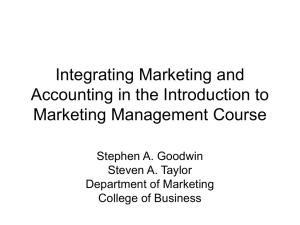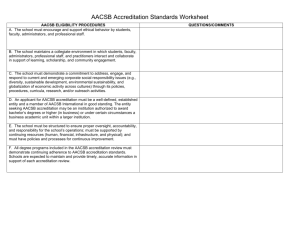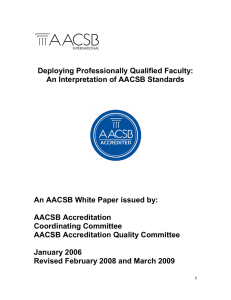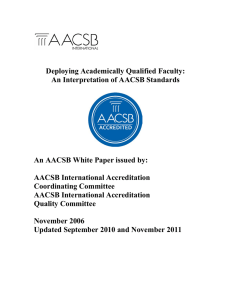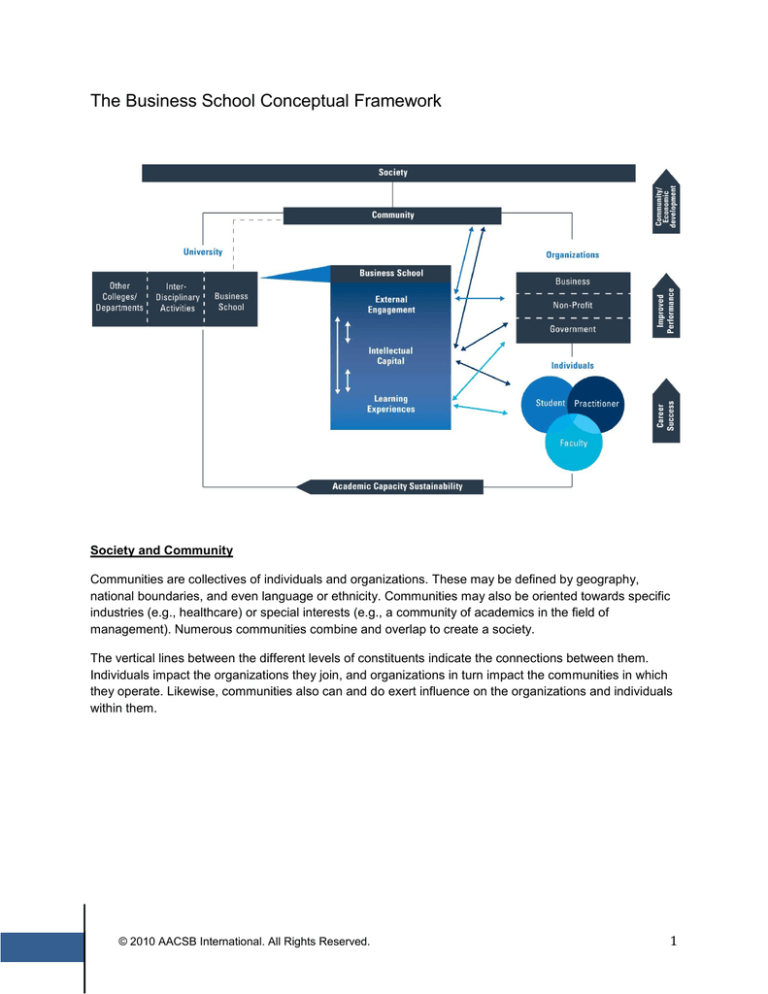
The Business School Conceptual Framework
Society and Community
Communities are collectives of individuals and organizations. These may be defined by geography,
national boundaries, and even language or ethnicity. Communities may also be oriented towards specific
industries (e.g., healthcare) or special interests (e.g., a community of academics in the field of
management). Numerous communities combine and overlap to create a society.
The vertical lines between the different levels of constituents indicate the connections between them.
Individuals impact the organizations they join, and organizations in turn impact the communities in which
they operate. Likewise, communities also can and do exert influence on the organizations and individuals
within them.
© 2010 AACSB International. All Rights Reserved.
1
University
(Other Colleges/Departments, Inter-Disciplinary Activities, Business School)
The mission of the business school is shaped, in part, by the context in which it operates–such as the
structural, geographic, regulatory, and cultural contexts of the institutions with which the school is aligned
(e.g., if the business school is a part of a larger academic entity) and the communities of which it is a part.
Although they operate with varying degrees of autonomy, business schools that are affiliated with a larger
academic entity also often have opportunities to engage in interdisciplinary activities with other academic
units. These interdisciplinary activities and strategies are just as much a part of how the business school
defines itself as the activities and strategies that it pursues independently.
Business School
(External Engagement, Intellectual Capital, Learning Experiences)
The business school is represented in the center of the framework. Like other organizations, business
schools operate in the context of one or multiple communities. Also, like other organizations, business
schools are comprised of individuals who unite to pursue shared objectives—namely the fulfillment of the
business school’s mission.
Within the business school, three distinct categories of activities are identified: delivery of learning
experiences, creation of intellectual capital, and community engagement. Note that these categories
correspond to different types of activities and are not intended to refer to a business school’s
organizational structure or division of resources. In fact, the dotted lines between the categories and the
arrows indicate that the activities are not always mutually exclusive, and that they can operate in
conjunction with or be influenced by actions in the other categories. Schools make choices, often driven
by the needs of the communities they serve, regarding their priorities among and within these activity
categories. It is through these choices that much of the differentiation among business schools occurs.
Two-directional arrows to the right of the business school illustration represent the relationships between
the school’s three basic activity categories and the constituent levels to which they are generally
connected. The arrows between the business school and its constituents are intentionally two-directional
in order to illustrates that, for example, intellectual capital is created with and by students and not just for
students. The arrows also point to essential growth opportunities for faculty from participating in teaching,
intellectual capital development, and service activities.
© 2010 AACSB International. All Rights Reserved.
2
Organizations
(Business, Non-Profit, Government)
Organizations are groups of individuals united to pursue a shared objective. An organization may be as
small as one or two individuals or be comprised of thousands. Each organization operates in the context
of one or more, often overlapping, communities.
Business schools (or the universities of which they are a part) are also organizations comprised of
individuals (e.g., faculty, staff, and students). The business school is isolated from other organizations
within this framework as it is AACSB’s intended focus and the basis for the relationships identified.
The vertical lines between the different levels of constituents indicate the connections between them.
Individuals impact the organizations they join and organizations in turn impact the communities in which
they operate. Likewise, communities also can and do exert influence on the organizations and individuals
within them.
Individuals
(Student, Practitioner, Faculty)
An individual is any one person or group of individuals with similar attributes and traits. A single individual
is likely to belong to or contribute to numerous ―organizations.‖ Likewise, the three categories of
individuals represented in the framework are not mutually exclusive. A part-time student would often fall
into both the ―student‖ and ―practitioner‖ categories. A doctoral ―student‖ may simultaneously fill a ―faculty‖
role by delivering courses to undergraduates. A ―faculty‖ member may teach part-time and also work in
industry.
The vertical lines between the different levels of constituents indicate the connections between them.
Individuals impact the organizations they join and organizations in turn impact the communities in which
they operate. Likewise, communities also can and do exert influence on the organizations and individuals
within them.
Outcomes
(Community/Economic Development, Improved Performance, Career Success)
Along the right edge of the framework are three categories of outcomes: career success, improved
performance, and community/economic development. Just as individuals, organizations, and
communities are related to each another, the outcomes associated with the interaction of business
schools and the constituent levels are also related. For example, a school may strive to improve the
performance of organizations directly through applied research, consulting, or custom courses. At the
same time, organizational performance may be improved indirectly through the enhanced capabilities of
the individuals it hires.
© 2010 AACSB International. All Rights Reserved.
3
Academic Capacity Sustainability
Along the bottom edge of the framework a fourth outcome category is introduced: academic
capability/sustainability. This category represents schools’ contributions to academic capacity by
educating individuals who become faculty and staff members. The engagement of faculty and staff
members in the business school, and their interactions with each other, also contribute to the academic
capacity of a school and help to sustain its operations. Finally, students, alumni, and practitioners are
sources of funding, as well as sources of feedback to ensure curriculum and research remain relevant.
© 2010 AACSB International. All Rights Reserved.
4




